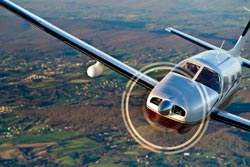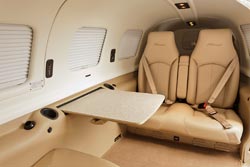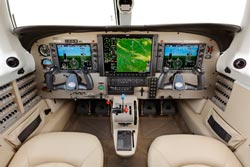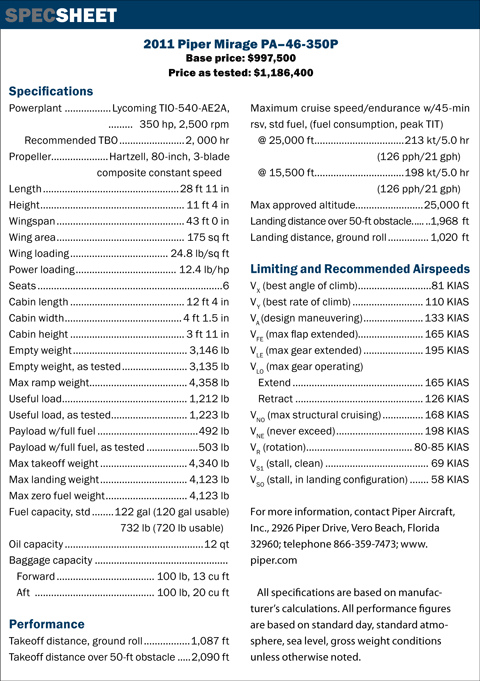Piper Mirage: Pressurization
Pressurization and cabin class set Mirage apart from the others
You might think that the primary driver of a pilot’s move from a piston airplane to a light turbine is the need for more speed, or range, or altitude. And while those factors certainly play a part in the decision, my recent conversations with pilots who have made the move suggest that the primary reason for the change was to get pressurization. Specifically, it was to provide a better experience for their spouses and other passengers.
One pilot who had been flying a turbocharged single told me he upgraded to a turbine because, “My wife complained endlessly about having to put on the ‘nose hose.’ She was the biggest advocate for the change. Now she comfortably sits in the back and reads or sleeps. I wish I’d done it sooner.”
For those who want the benefit of turbine capabilities in the form of pressurization, known-icing certification, and redundant systems in a single-engine piston aircraft, there is only one option in new production airplanes: the Piper Mirage. With its 350-horsepower dual-turbocharged, dual-intercooled Lycoming TIO-540 engine, the sleek Mirage cruises at nearly 215 knots true airspeed, at altitudes up to 25,000 feet. While turbine airplanes will cruise faster, the Mirage’s maximum range of more than 1,300 nm means that if a fuel stop can be skipped, the piston airplane may well arrive at its destination before a thirsty turbine airplane with fuel stops en route.
 As Piper Executive Vice President Randy Groom is quick to point out, not only is the Mirage the only pressurized piston airplane in production, it is one of the few piston airplanes ever built that was designed from the beginning to be pressurized. The result is a stout fuselage with an even stouter air stair door that closes tightly and assuredly—something that few unpressurized airplanes seem to accomplish well. A large baggage area behind the aft seats can be expanded by flipping the aft seat backs forward—or, as many owners do, removing a rear seat for even more space. A center aisle through the club-configured cabin allows access to the flight deck, which houses a three-screen Garmin G1000 suite.
As Piper Executive Vice President Randy Groom is quick to point out, not only is the Mirage the only pressurized piston airplane in production, it is one of the few piston airplanes ever built that was designed from the beginning to be pressurized. The result is a stout fuselage with an even stouter air stair door that closes tightly and assuredly—something that few unpressurized airplanes seem to accomplish well. A large baggage area behind the aft seats can be expanded by flipping the aft seat backs forward—or, as many owners do, removing a rear seat for even more space. A center aisle through the club-configured cabin allows access to the flight deck, which houses a three-screen Garmin G1000 suite.
The two 10-inch primary flight displays support Garmin’s Synthetic Vision Technology, providing a VFR experience on the most weather-challenged day. The commanding 15-inch multifunction display continuously depicts engine and system parameters down the left side. A small crew alert system window in the lower left is dark except when a system anomaly needs pilot attention. The balance of the display is given over to moving maps, weather and flight planning information, and a plethora of other data that provide for increased situational awareness.
Just below the MFD is the GFC 700 autopilot computer. As in other GFC 700 installations, the Mirage system includes a dizzying array of autopilot modes that, once mastered, make simple work of flying the airplane. And while satellite-delivered text and graphical weather provide excellent strategic in-flight information, Mirage pilots have the option of ordering the Garmin GWX 68 weather radar for more tactical weather avoidance. The radar antenna is housed in a small pod under the right wing.

As with turbine airplanes, the Mirage comes standard with many redundant systems, including dual attitude heading reference systems (AHRS) and dual air data computers, as well as dual alternators and vacuum pumps. A single lead-acid battery provides additional power should both alternators fail. Mechanical back-up gauges next to the pilot’s PFD provide redundancy.
The standard air conditioning system actually works, quickly cooling the cabin even on a steamy Florida day. Pressurization systems on the newest turbine airplanes are essentially automatic—the pilot need only set the elevation of the destination airport before takeoff—but the Mirage’s pressurization system requires more input by the pilot. In the climb, the pilot sets the system to about 500 feet above the intended cruise altitude, so step-climbs may require several system adjustments. In the descent, if a level-off occurs, the pilot must set an altitude just above the intermediate altitude. Once at lower altitude, the elevation of the landing field plus 500 feet is entered and the system is set, assuring a depressurized cabin well before landing. A maximum 5.5-psi differential means that at the airplane’s maximum altitude of FL250, the cabin is at a comfortable 8,000 feet; no nose hose required.
 Another turbine-like feature of the Mirage is the optional deicing system. Inflatable rubber boots on the wing and tail leading edges are pressurized by the ship’s vacuum pumps to break ice off of the surfaces. The Mirage pilot information manual recommends cycling the boots when ice accumulations reach between one-quarter and one-half inch. Electrically heated boots near the hub on the leading edge of the composite propeller blades keep the prop free of ice. Electric elements in the windshield keep that surface ice-free. A switch panel next to the co-pilot’s yoke manages the environmental and deice/anti-ice systems.
Another turbine-like feature of the Mirage is the optional deicing system. Inflatable rubber boots on the wing and tail leading edges are pressurized by the ship’s vacuum pumps to break ice off of the surfaces. The Mirage pilot information manual recommends cycling the boots when ice accumulations reach between one-quarter and one-half inch. Electrically heated boots near the hub on the leading edge of the composite propeller blades keep the prop free of ice. Electric elements in the windshield keep that surface ice-free. A switch panel next to the co-pilot’s yoke manages the environmental and deice/anti-ice systems.
With its spiky nose; rakish three-blade composite Hartzell prop; tall gear; long, slender wing; and air stair door, the Mirage creates a big ramp presence. In fact, aside from the length and shape of the nose and the exhaust stacks, many confuse the Mirage with its turbine-powered brother, the Meridian—even fuelers, so pilots of each model need to make sure they are getting the right kind of go-juice.
With the preflight complete and the Lycoming humming, I nudged the new Mirage out of its parking space on the ramp outside Piper’s Vero Beach, Florida, factory. In the right seat, Piper Flight Test Pilot John Kronsnoble worked the radios. Spending most of my time in nonpressurized airplanes, I am always pleasantly surprised at how quiet pressurized airplanes are inside. It seemed as if the big Lycoming was about a block away rather than a couple of feet in front of my feet.
After departing Vero Beach, we headed northeast toward, appropriately, PIPER intersection. A cruise climb at 35 inches of manifold pressure and 2,500 rpm gave us a climb rate of about 800 feet per minute at 125 KIAS and 32 gph, leaned to peak turbine inlet temperature (TIT).
Leveling off at FL230, we set up for high-speed cruise at 32 inches and 2,500 rpm. A nice thing about the Mirage is that you almost never have to touch the propeller control. At 20.4 gph and leaned to a TIT of 1,750 degrees, the airplane settled in at 214 TAS, about four knots faster than book. Under optimal conditions, the maximum book speed is shown as 213 knots. Kronsnoble’s rule of thumb for the Mirage is to expect 210 knots true on 21 gph at FL210—the rule of 21s, if you will.

An economy cruise setting provides lots of endurance, if that becomes more important than speed. At 26 inches and 2,200 rpm, leaned to a peak TIT of 1,650 degrees and 13.4 gph, true airspeed dipped to 184 knots—but endurance, with 120 gallons of fuel available, would stretch to more than 6.5 hours, accounting for climb fuel and a 45-minute reserve. Later, we plummeted back to Vero Beach with the standard speed brakes deployed, allowing for eye-opening descents while keeping the engine from cooling too fast.
The capable and well-equipped Mirage suffers from the same problem that faces every new airplane today: limited useful load. With a maximum ramp weight of 4,358 pounds, an empty weight of 3,135 pounds for the well-equipped airplane we flew, and all 120 gallons of fuel on board, useful load is about 503 pounds; so two people and bags, or three people and briefcases. But those 120 gallons allow for trips of more than five hours at high-speed cruise, including climb fuel and 45 minutes of reserve. With most trips less than 500 miles, there’s plenty of flexibility to trade fuel for additional cargo or passengers.
A 500-mile trip at high-speed cruise would require only about 58 gallons, allowing for four onboard and lots of bags. The pressurization, radar, air conditioning, deicing boots, leather interior, writing table, and other accoutrements come with a weight penalty. Those wanting similar performance, but not so concerned about wearing oxygen masks, can opt for the Piper Matrix, which is basically an unpressurized Mirage. The weight savings amount to about 150 pounds, depending on options.
 Regardless, the Mirage is highly competitive from a payload standpoint, on par or better than most other high-performance piston airplanes, and also from a value standpoint. Piper recently lowered the typically equipped price by about $100,000, depending on options. The airplane I flew, N2365S, which included weather radar, boots, traffic, Jeppesen electronic charts, and a host of other options, listed for $1.187 million.
Regardless, the Mirage is highly competitive from a payload standpoint, on par or better than most other high-performance piston airplanes, and also from a value standpoint. Piper recently lowered the typically equipped price by about $100,000, depending on options. The airplane I flew, N2365S, which included weather radar, boots, traffic, Jeppesen electronic charts, and a host of other options, listed for $1.187 million.
Customers are noticing the value. Piper is increasing annual Mirage production by 30 percent in 2011, but dealers are still reporting Mirages difficult to find in their network as Matrix customers decide to move up to pressurization and Cirrus buyers look for their next step up the aviation ladder. For the price, the owners will get a highly capable airplane with the oxygen masks stowed out of the way and most likely never needed.
Email the author at [email protected]. Photography by Mike Fizer .



